Credit: ResearchSEA
Toxicologists in Malaysia published the first report on the venom proteome correlating toxic functionalities of the Malayan blue coral snake, an exotic species from the country. The toxins are unique among snakes and have deep implication on antivenom production and drug discovery.
People first heard about "coral snakes" might naturally think that the snakes live in the sea, hiding, swimming and lurking in and around some beautiful coral reefs. But the truth isn't so, as coral snakes are totally terrestrial (living on land), preferring forested habitat that offers land for burrowing and hiding. Why "coral"? Because of the stunning, breathtaking colors in most of the species.
The Malayan Blue coral snake, Calliophis bivirgata, is perhaps the largest species of its kind. Adult snakes typically grow beyond a meter in body length. The body color is striking to the eyes: bright-red color on the head continuous throughout the underside of the body to the tail, while the back of the body is dark blue to black in color, flanked by a pair of bluish white stripes running along each side (Fig. 1). The dramatic body color is believed to serve aposematic purpose (as a warning message of "Stay away from me, I am deadly!" to ward off predators). Coral snakes are elusive and shy; when confronted, they usually slither away or seek hiding spot to avoid the source of aggression.
Beautiful, attractive, but dangerous – this is the nature of blue coral snake. All coral snakes belong to the Elapidae Family of the Serpentes Order. For those uncertain about snake taxonomy, "famous" members in the Elapidae Family include cobras, kraits and sea snakes. A common characteristic of these snakes is that they all pack and carry a battery of lethal toxins called "venom" in specialized oral glands, to be injected through the venom fangs when in need. So what is exactly "venom"? For snakes, it is a critical phenotype that has ecological significance, where it functions to take down prey and to defend the snake from predator. Mishaps however can occur from unpleasant encounters between humans and the snake, resulting in snakebite envenomation.
Therefore, coral snakes are considered medically important venomous snakes. Knowledge on their venom property is essential not only for clinical management but also drug discovery, a field in which new medicines are developed from natural compounds (yes, snake toxins are natural compounds). However, studies pertaining to the Old World or Asiatic coral snake venoms are limited, presumably due to the inaccessibility to the venom of these exotic species.
With persistence, Dr. Tan Choo Hock and team at University of Malaya, Malaysia, managed to collect the venom from the Malayan blue coral snake and the venom has been characterized on two major aspects: (a) proteomics that unveils the various toxin components and their amounts in the venom; (b) biomedical studies of the venom to understand it toxicological properties. The advent in proteomic tools such as high-resolution mass spectrometry and powerful bioinformatic analysis, has led to an impressive growth in the knowledge about venom composition, thus enabling a holistic correlation of venom profile to toxicity and medical treatment. In fact, the paper published by the researchers is the first report of the venom proteome of an Asian coral snake in correlation to its venom biology. The blue coral snake venom is unique; it is predominated by phospholipase A2 and three-finger toxin, together accounting for approximately 60% of total venom proteins. However, it varies distinctly from the venoms of many other elapid snakes such as cobras, king cobra, kraits, sea snakes and even the American coral snakes, by the peculiar absence of post-synaptic alpha-neurotoxins in its venom profile. Instead, the unique cytotoxin isoform, maticotoxin, comprises the second largest bulk of proteins in the venom, following phospholipase A2. This implies the emergence of a dichotomous venom phenotype within the Elapidae family. The novel mechanisms of the blue coral snake venom and its toxin deserve further investigation.
The unique proteome of blue coral snake venom has also offered insights into the toxic functionalities of snake venom. Meanwhile, although the venom is lethal, there is a lack of appropriate antivenom that can effectively neutralize the venom. In essence, the venom proteome unveiled for this exotic snake has enriched the snake toxin databases, and this can contribute to drug discovery and the optimization of antivenom production in the region.
More information: Choo Hock Tan et al. Unveiling the elusive and exotic: Venomics of the Malayan blue coral snake (Calliophis bivirgata flaviceps), Journal of Proteomics (2016). DOI: 10.1016/j.jprot.2015.11.014
Provided by University of Malaya























